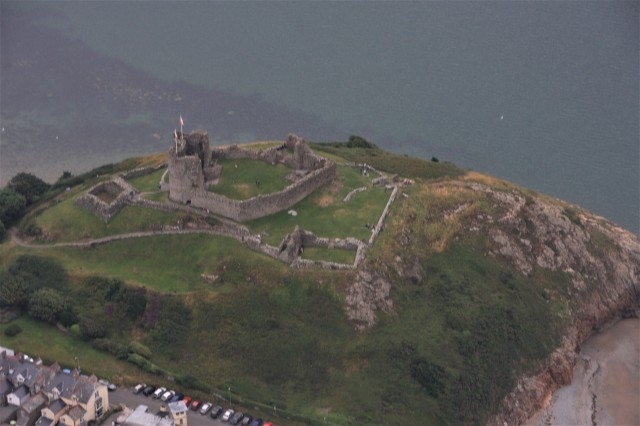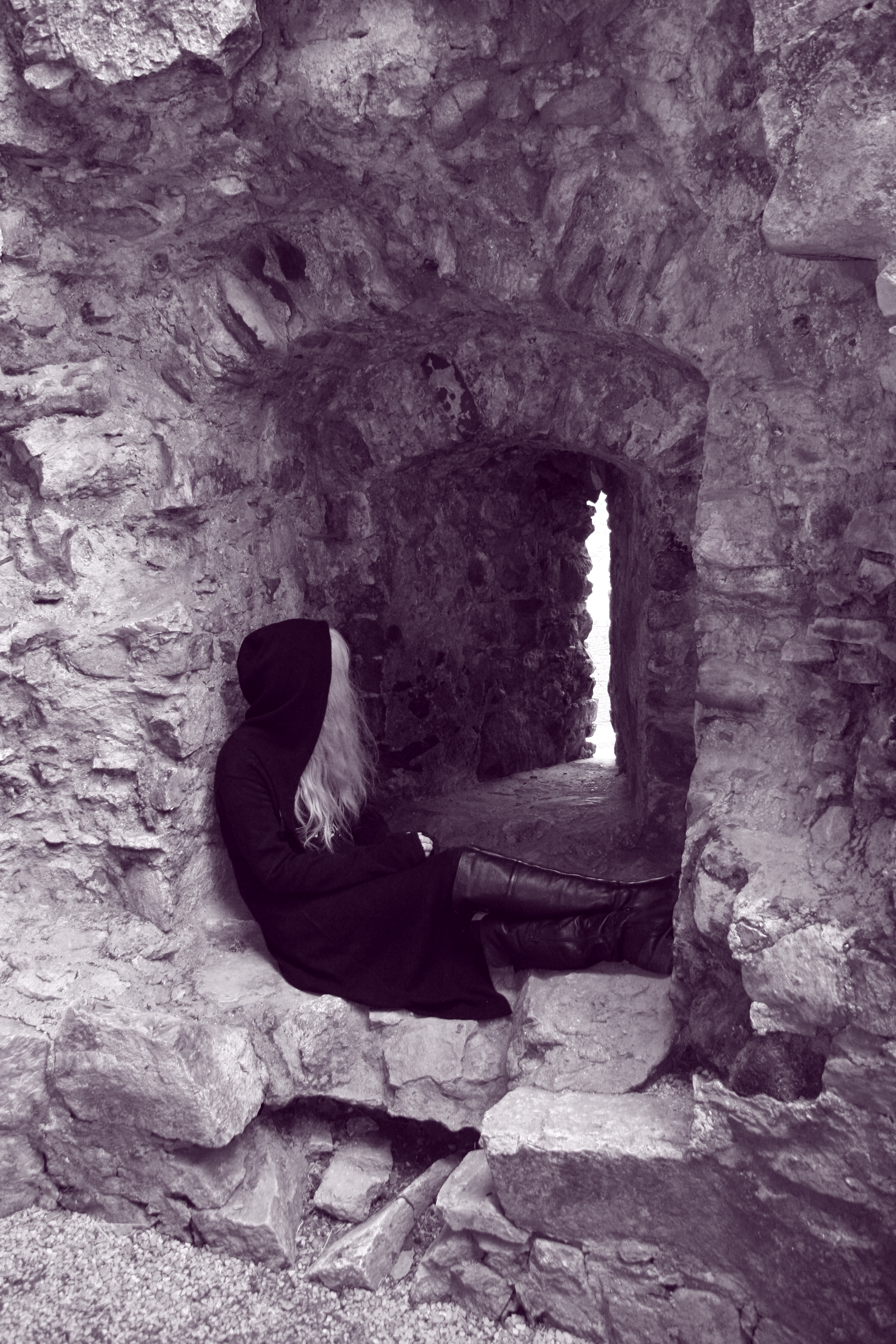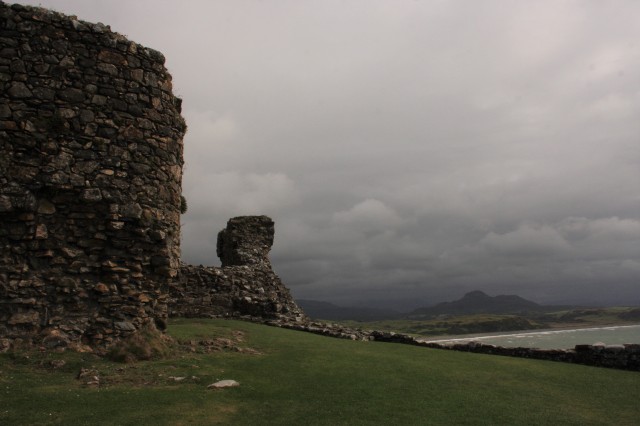In the Epilogue of my Welsh Quest, I mentioned that we might find another couple of castles to visit during the rest of our stay in North Wales. And believe it or not, we did. But these bonus finds weren’t built by Edward 1st, they were the power projects of the native Welsh princes long before the warrior English king pitched up to claim them.
When I flew from Caernarfon down to Harlech to photograph the castles from the air, we also passed this little gem. I looked down to see Criccieth Castle sitting pretty atop a rocky promontory on the north-eastern corner of Cardigan Bay. So I couldn’t resist taking a few snaps of this modest, yet commanding fortress. And when we visited it on the ground I discovered it was not only built by a Welsh prince, it was also destroyed by one, while its reputation for fine hospitality moved a Welsh poet to immortalise it in verse.

The castle perched on it’s high hill by the sea
The first castle on the site was almost certainly built by Llywelyn ab Iorweth, or ‘Llywelyn the Great’ as he became known, grandfather of Llywelyn ap Gruffudd, whose stand against Edward 1st resulted in the Welsh wars of my Quest. By 1201, Llywelyn the Great had emerged as ruler of most of Wales, a position that was strengthened when in that same year the English King John recognised his right to rule. Four years later John even welcomed the Welsh prince into his family by arranging his marriage to his own illegitimate daughter, Joan.

Location is everything: the sea provided excellent natural defences
It’s believed that Criccieth was built in the 1230s, when Llywelyn transferred his power base to this new site within his expanded territories. The location was an obvious choice for a successful Welsh ruler. Nature had provided perfect sea-cliff defences, leaving just the landward side to be fortified with earthworks, and the lofty position gave out an unmistakable statement of power and authority, and made an ideal lookout point for mountain passes, borders and grazing land. Borrowing from the latest in English castle design, Llywelyn built a twin-towered gatehouse, complete with ground floor arrow slits and comfortable accommodation on the first and second floors. The gatehouse passage led into the inner ward where the now vanished great hall and kitchen would have stood, constructed against the inside of the curtain wall. When the prince was in residence, it was to this relatively modest but nevertheless impressive royal fortress that he would summon important people to meetings by day, while the evenings were given over to feasting around the open fire. But to reach its heyday of fun and fine living, Criccieth would have to wait until the next century.

The impressive inner gatehouse was originally built by Llywelyn the Great

Relaxing in the inner gatehouse and admiring the view through one of the arrow slits
Llywelyn’s son and heir, Dafydd, was less successful than his father. To keep control of his lands, Dafydd imprisoned his own brother and nephew at the castle. But with power struggles and turmoil rearing their heads, it was left instead to Llywelyn’s grandson, Llwelyn ap Gruffudd to re-establish the dynasty’s rule in Wales. As anyone who followed my Quest will know, this Llywelyn was initially even more successful than his ‘Great’ forebear, being formally acknowledged as Prince of Wales by the English King Henry III. During his rule he enlarged Criccieth by adding an outer ward to enclose the entire hilltop, including new towers and an outer gatehouse. But as we now know, Llywelyn became known as ‘the Last’ of this native princely dynasty when he fell foul of Edward 1st, losing his life in a skirmish during the second Welsh war in 1283. So after he died, the English king took over all his lands, including Criccieth.

From the air you can clearly see the layout of the outer ward added by Llywelyn ap Gruffudd

Looking across the outer ward to the sea

The town of Criccieth lies at the base of the castle rock
Edward made further alterations to the castle, heightening the original gatehouse, repairing towers and building a ‘King’s Hall’ in the inner ward, and he established a ‘free borough’ at Criccieth, bringing in settlers from Shropshire. But by the end of 13th Century the arrival of prisoners from Edward’s subsequent Scottish war saw the castle revert to a place of incarceration, and there are further references to prisoners being kept there until its destruction. But it wasn’t bleak for all the people who stayed at the hilltop fortress, because in the hands of a 14th Century war hero, it gained its reputation as a party palace.

These wall footings near the south gate suggest domestic activity within the inner ward
In 1359, the Black Prince, son of Edward III, made his brother-in-arms, Sir Hywel ap Gruffudd, Criccieth’s first Welsh constable. A local man and a descendent of Welsh nobility, Sir Hywel ꟷ also known as Sir Hywel of the Axe ꟷ had distinguished himself fighting alongside the Black Prince at the Battle of Poitiers in 1356. His twenty years at the castle earned him the praise of a Welsh poet, Iolo Goch, who described a sophisticated and stylish court with the ageing Sir Hywel and his wife at its centre. According to the poem, hospitality abounded with music, singing and dancing, while games were played in the great hall and beautiful maidens wove vibrant silks in this ‘marvellous fine castle’:
The fair wall which you see
a good dwelling to come to
and the bright fort high on a rock
and the red stone on the edge of a croft,
this is Criccieth and its New work
an old edifice that is.

The view to the south – Harlech is out there somewhere!
But all good times come to an end, and towards the end of the 14th Century unrest was growing in Wales again, and in 1400 the Welsh rebel Owain Glyndŵr led a revolt, attacking several boroughs in north-east Wales. The uprising spread throughout the country, and by 1403, Owain had gained control of much of the area surrounding Criccieth, and the castle, along with those at Harlech and Aberystwyth fell to sieges by Welsh forces. Owain himself made Harlech his royal court after being proclaimed Prince of Wales, leaving Criccieth and its borough to be destroyed by his followers. Another poet, Owain Waed Da, now described a very different castle, telling us that the: ‘rocky stones of the stone wall’ had fallen and the castle was now useless.

A castle in ruins – but it still holds a commanding presence over the area…
Criccieth was never to see those glory days of hospitality again, and it was never rebuilt. But the ruin still lingers, crowning that towering hill by the sea, and reminding people through the centuries of its rich history. As I wandered around the remains of this lovely Welsh fortress I could almost hear the music playing and the songs echoing through the ragged walls, and it’s easy to imagine how the place would have been when the good times rolled and the mead flowed…
…and talking of mead, we’ve just started brewing our own. My new Quest to discover all about honey wine is getting underway…
A great post my love – what a fascinating history this little castle has.
I did really enjoy our visit, It was a fantastically atmospheric place – even with the force nine gale blowing!
LikeLiked by 1 person
Ah, that was nothing… nothing could destroy the fantastic feel of that place… 🙂
LikeLiked by 1 person
Agreed! I think it added to it! 😀
LikeLiked by 1 person
Despite travelling extensively around North Wales, I don’t think I’ve ever been to Criccieth – looks well worth a visit, if only to have a look around that castle.
Must have been awful for the folk in the dungeons with all the constant partying going on overhead (if they could hear it). I don’t think I’d be very happy being at a party either if I knew people were in the dungeons suffering below. But then I suppose people thought differently back then…
LikeLiked by 1 person
The castle really is worth a visit. It’s way up high over the town, and the views from the top are outstanding.
You’re right of course, people did think differently back then. The prisoners would have been seen as the enemy, so needed to be kept safely out of the way. Of course, many prisoners of noble rank were ransomed back to their families so they would have been kept until the money was paid. Prison back then wasn’t a punishment in itself, it was a containment exercise while the prisoner either waited for a trial, or their captors waited for the money for their release. A very different world from today… 🙂
LikeLike
I’m starting to think that, here, nowadays, the only way you can be imprisoned for a long time is to defraud the officials or something. You certainly don’t get much for violence and so on! 😦
LikeLiked by 1 person
It does seem like that, yes. I reckon we’ve gone too far the other way today. We’ve gone soft. 😦
LikeLike
I really enjoy your posts, this stuff fascinates me.
LikeLiked by 1 person
Thank you, River. That’s really good to know. Glad you enjoy them. 🙂
LikeLike
You’re welcome. I appreciate all the effort you put into these posts.
LikeLiked by 1 person
Thank you, River. It’s a labour of love, driven by a passion for all things medieval. It was a magical time… 🙂
The feeling is mutual. I appreciate all your beautifully crafted poetry.
LikeLiked by 1 person
You’re very welcome.
LikeLiked by 1 person
Criccieth has a fabulous situation. We were there, briefly, at the height of summer a few years ago. Even with the town swarming with tourists, the castle still has a presence that makes itself felt.
LikeLiked by 1 person
It certainly does, Sue. Massively so. And those views… 🙂
LikeLike
I know. The headland across the bay intrigued us.
LikeLiked by 1 person
It’s a wonderful area to explore. From the air, overhead Criccieth, I could just make out Harlech in the distance.
LikeLike
We had been there the previous afternoon too.
LikeLiked by 1 person
Ah, another beautifully positioned castle. 🙂
LikeLike
Fabulous, sespecially from the road that now runs beneath the seaward side.
LikeLiked by 1 person
Absolutely, you can’t help but wonder about the impact these castles would have had on the surrounding lowly population, especially with the lofty positioning. Even now they scream of power and authority. 🙂
LikeLike
Which, I suppose, was exactly the point they were designed to make 😉
LikeLiked by 1 person
Yes, indeed. And boy did it work… 🙂
LikeLike
Oh yes 🙂
LikeLiked by 1 person
🙂
LikeLiked by 1 person
So much history for the castle! Really sounded like it was the fun place to be there for a while. So interesting to read. And good luck with the mead production! Excited to read how that turns out!
LikeLiked by 1 person
Thanks Robyn. It’s a great little castle to look round and the views from the top of that hill are amazing. We’re looking forward to the mead – very exciting to be brewing our own! Fingers crossed for a tasty result! 🙂
LikeLiked by 1 person
Fascinating period of history – Borrow mentions some of this in Wild Wales. It all fascinated him.
LikeLiked by 1 person
It is indeed, John. I would like to have a look at Borrow before I start my final module next year on Welsh history. No prizes for guessing what era I’ll be concentrating on! Thanks for reading. 🙂
LikeLiked by 1 person
He has some interesting bits on medieval Wales.
LikeLiked by 1 person
I look forward to it. Seems as though it’s right up my street… 🙂
LikeLiked by 1 person
What an excellent account of one of the lesser known castles of North Wales Alli. I always enjoy seeing people’s photographs of the places they’ve visited, but not too many have the chance to take ariel shots like you’ve got here. Great post!
LikeLike
Thanks Malc, I’m glad you enjoyed my wander round – and over! – Criccieth. It’s a lovely little place, and being able to take some aerial photos really helps to show the castles in their setting. And this was a really great setting… 🙂
LikeLiked by 1 person
I’m pleased to hear that you’ve started the Mead quest up. Just for the record, I’m replyng to your comment via my WordPress. com account to see if it’s any different from my Easymalc’s Wanderings account,
LikeLike
It looked quite a promising ‘must’, and is bubbling away…
This came up in my notifications ok. Hope that helps.
LikeLike
This is wonderful — wish I could show up for some mead but it’s pretty far.
LikeLiked by 1 person
Thanks Martha. I’d be careful what you wish for with the mead – we don’t know what it’ll taste like yet! Still, I’d love to share a glass of honey wine with you, but for now we’ll drink a toast to you across the miles! Hopefully, our own brew will pass muster when it’s ready. It’s an exciting thing to be doing 🙂
LikeLiked by 1 person
Toast Hrothgar on my behalf when the time comes. With the next batch, toast Njal. ❤
LikeLiked by 1 person
Brilliant suggestion, Martha! I’ll drink to that! ❤ 🙂
LikeLiked by 1 person
Hope your mead comes out well!
And looking forward to hearing about it
And this post is alli-terrific history ☀️
The ending photo really does show its commanding presence and how many folks walk by it every day and likely pay it no mind!
Hmmmm
LikeLiked by 1 person
I’m sure you’re right, Yvette. People just don’t see these wonderful landmarks when they live alongside them. Mind you, I think I would never tire of it if I lived there, it really is a striking sight. Glad you enjoyed Criccieth, and fingers crossed for some good Templeton mead to come. Update next week… it’s looking promising! 🙂
LikeLiked by 1 person
😊☀️
LikeLike